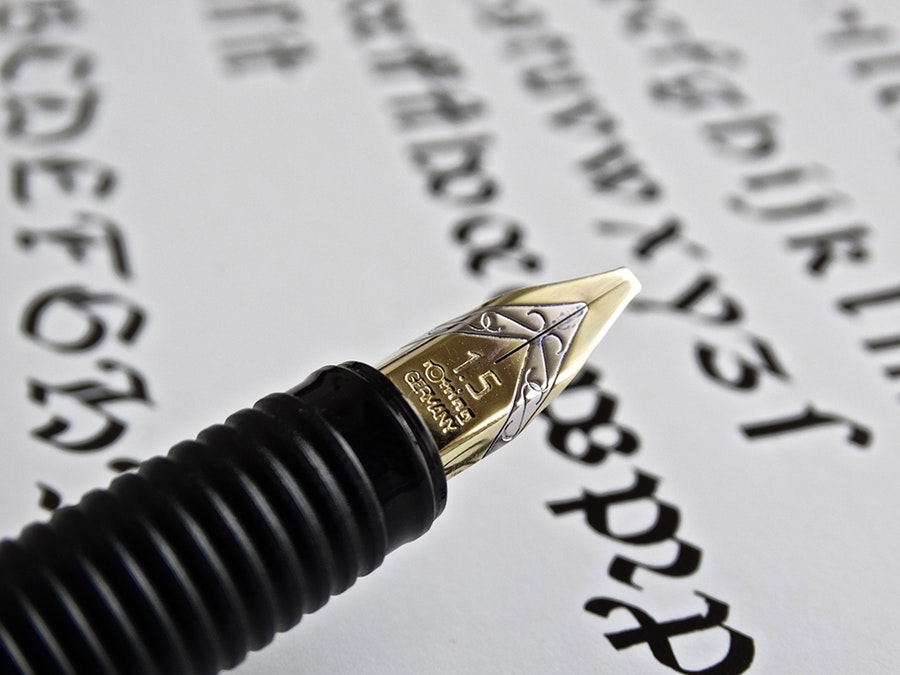
Some think that the art of handwriting –penmanship or calligraphy- is condemned to a slow but sure death.
Certain educators expound that cursive writing is not a XXI-century skill and that it has reached the end of the line.
I differ.
I am keyboarding this short article, but before I sat at the computer I took notes –musings and ideas- longhand … worse still, in cursive, not in block letters.

Yes, I still handwrite notes
Am I a dying breed, obsolete and weird?
Or am I ahead of my time, taking advantage of the new while using the old to my benefit?
I want it all, I want to have the pie and eat it too.
Why do you still use a fountain pen, you may ask. Am I right in employing handwriting instead of typing?
Why do I still compose letters of condolence in cursive handwriting?
I never e-mail a friend my feelings on the passing of a relative of his; instead I pull out my stationery, brandish my fountain pen and set myself to the arduous, heart-shrinking task of composing a note that will show my innermost feelings and sympathy to my friend, using my handwriting, a handwriting that is mine and almost impossible to reproduce or forge, a part of myself.

At times like these, the keyboard is impersonal and cold.
Friendship means giving of ourselves, our time, our feelings, our personality, and we can express all that only when the nib of the pen slides on the paper, letting the ink flow naturally, shaping the letters, our letters, the way we form them, into words and as the hand moves from left to right in a slow and smooth travel across the paper.
When my friend gets the letter–yes, I go to the Post Office and mail it–he will recognize my handwriting on the envelope.
Also read: Keeping the over-50 brain nimble and sharp

As he reads my note, he will know that I took the time to pen it slowly, and with the care he and his family deserve.
To paraphrase Bertrand Russell, no keyboard will ever replace the human warmth of a handwritten note that often will keep away the chill of the universe, the loneliness of human beings.
The artistic skill of using the dexterity, fluidity and the right amount of pressure needed to compose the letters and the words, employing neuromuscular mechanisms that are unique in each one of us, makes writing by hand a mirror of our personality.
No two handwritings are the same
All typing is the same, clear but impersonal.

Graphologists will tell us that a person’s character and personality can be discerned from the way she crosses her t’s, dots her i’s or the way she links letters, by how small or big she draws words.
Sloppy handwriting shows sloppy thinking, and a sloppy personality. And it is a fact that it is possible to change one’s character by changing one’s script.
In Europe a person’s character and general education are still judged by the way he writes with a pen, and block lettering is considered a sign of poor schooling.
In the United States some misguided educators are breaking a lance for block letters instead of cursive writing, arguing that who cares, after all, because students are going to type and text, anyway.
They do not seem to be aware of the plasticity of the brain and the link between neurons and muscular activity, which makes all of us unique, similar but unique.
And just as we all have a nose and two eyes which are always different, we produce cursive writing differently as a reflection of the neuromuscular actions which are always unique.

Quill, ink horns, blotting paper, penknives may have gone down the drain of history… but it would be a mistake to do away with handwriting, with cursive writing in particular, because it helps us to reflect and think slowly, to shape our own ideas with our very own artistic lettering.
Friedrich Nietzsche (1844-1900) wrote in his preface to The Dawn, (1881): “I am not a philologist in vain – perhaps I am not one yet: a teacher of slow reading. I even come to write slowly.

At present it is not only my habit but even my taste…
For philology is that venerable art which exacts from its followers one thing above all, to leave themselves spare moments, to grow silent, to become slow — the leisurely art of the goldsmith applied to language: an art which must carry out slow, fine work, and attains nothing if not lento.…”
Penmanship teaches clear and orderly thinking.
Do not allow your children to lose this artistic skill that will keep them in good stead in later years, and take it up on yourself to teach them if the school they attend does not.






Leave a Reply